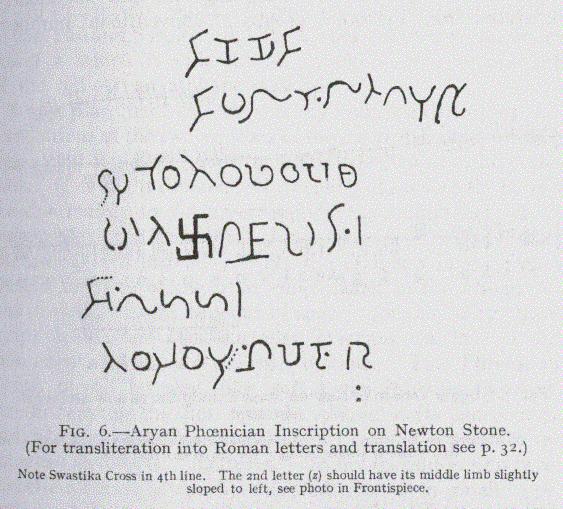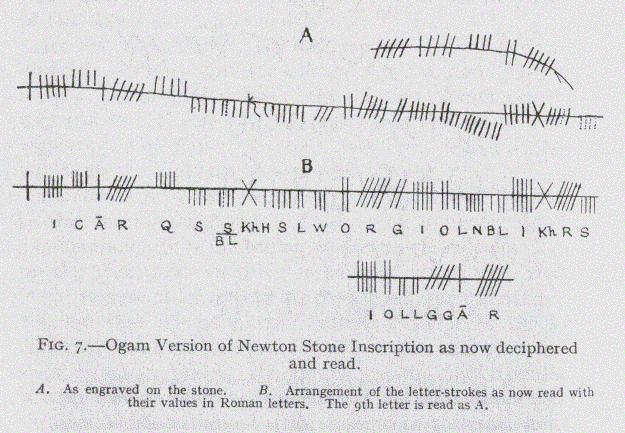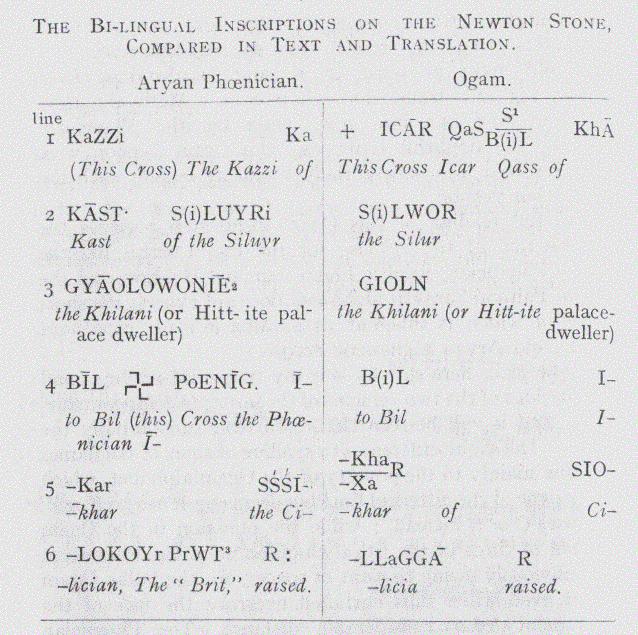Chapter IV
DECIPHERMENT AND TRANSLATION OF THE PHOENICIAN
INSCRIPTIONS ON THE NEWTON STONE
Disclosing Monument to be a votive Fire-Cross to the Sun-god
Bel by a Phoenician Hittite Brit-on and the script and language
Aryan Phoenician or Early Briton
WHEN I first saw this "unknown" script of the central inscription on
the Newton Stone many years ago, in the plates of Dr. Stuart's classic
"Sculptured Stones of Scotland," I formed the opinion that that
learned archaeologist was right in his surmise that the writing was
possibly in "an eastern alphabet." I further recognized that it was
presumably a form of the early Phoenician script, cognate with what I
had been accustomed to in the Aryan Pall script of India of the third
and fourth century B.C.; and I thought it might be what I had come to
call "Aryan Phoenician," which it now proves to be.
At that time, however, I did riot feel sufficiently equipped
to tackle the decipherment of this inscription in detail.
But having latterly devoted an entire time for many years
past to the comparative study at first hand of the ancient
scripts and historical documents of the Hitt-ites, Sumerians,
Akkads, AEgeans and Phoenicians, and the Aramaic, Gothic
Runes and Ogams, I took up again the Newton Stone
inscriptions for detailed examination. some time ago. And
I found that the "unknown" script therein was clearly
what I term "Aryan Phoenician," that is true Phoenician,
and its language Aryan Phoenician of the Early Briton of
Early Gothic type.
By this time, I had observed that the early inscriptions of the
Phoenicians were written in Aryan language, Aryan script, and in the
Aryan direction, that is towards the right
26
p.27: DECIPHERMENT OF NEWTON STONE
hand. The so-called "Semitic Phoenician" writing, on the other
hand, with reversed letters, and in the reversed or left-hand
direction, and dating mostly to a relatively late period, was, I
observed, written presumably by the ruling Aryan Phoenicians for the
information of their Semitic subjects at their various settlements;
and by some of these Phoenicianized Semitic subjects or allies helping
themselves to and reversing the Phoenician letters. It was obviously
parallel to what we find in India in the third century B.C., where the
great Aryan emperor of India, Asoka, writes his Buddhist edicts in
reversed letters and in reversed or "Semitic" direction, when
carving them on the rocks on his northwestern frontier in districts
inhabited by Semitic tribes; yet no one on this account has suggested
or could suggest that Asoka was a Semite.
By this time also, I had recognized that the various ancient scripts
found at or near the old settlements of the Phoenicians, and
arbitrarily differentiated by classifying philologists variously as
Cyprian, Karian, Aramaic or Syrian, Lykian, Lydian, Korinthian,
Ionian, Cretan or "Minoan," Pelasgian, Phrygian, Cappadocian,
Cilician, Theban, Libyan, Celto-Iberian, Gothic Runes, etc., were all
really local variations of the standard Aryan Hitto-Sumerian writing
of the Aryan Phoenician mariners, those ancient pioneer spreaders of
the Hitt-ite Civilization along the shores of the Mediterranean and
out beyond the Pillars of Hercules to the British Isles.
In tackling afresh the decipherment of the Newton Stone inscriptions,
in view of the hopelessly conflicting tangle that had resulted from
the mutually conflicting attempts of previous writers, which proved a
hindrance rather than a help to decipherment, I wiped all the previous
attempts off the board and started anew with a clean slate and open
mind.
The material and other sources for my scrutiny of these Newton Stone
inscriptions have been a minute personal examination of these
inscriptions on the spot, the comparative study of a large series of
photographs of the stone by myself and others, including the
published
p.28: PHOENICIAN ORIGIN OF BRITONS & SCOTS
photographs and eye-copies by previous writers, and the
careful lithographs by Stuart from squeeze-impressions and
photographs.
In constructing the accompanying eye-copy of the uniquely important
central inscription, here given (Fig. 6), I scrupulously compared all
available photographs from different points of view, for no one
photograph can cover and focus all the details of these letters owing
to the great unevenness and sinuosities of the inscribed surface of
this rough boulder-stone. It will be seen that my eye-copy of this
script differs in some minute but important details from those of
Stuart and Lord Southesk, the most accurate of the copies previously
published.
In my decipherment of this central script I derived especial
assistance from the Cilician, Cyprian and "Iberian"
scripts and the Indian Pali of the third and fourth centuries B.C. and
Gothic runes, which were closely allied in several respects; and
Canon Taylor's and Prof. Petrie's classic works on the alphabet also
proved helpful.
So obviously Aryan Phoenician was the type of the letters in this
central script, when I now took it up for detailed examination, that,
in dealing with the two scripts, I took up the central one in this "unknown" script first, that is in the reverse order to that adopted
in all previous attempts. I found that it was Aryan Phoenician script
of the kind ordinarily written with a pen and ink on skin and
parchment, such, as we are told by Herodotus, was the chief medium of
writing used by the early inhabitants of Asia Minor; and the
perishable nature of such documents accounts for the loss of so much
of the original literature of the Early Aryans both in Asia Minor and
in Britain.
On deciphering in a few minutes most of the letters in this Phoenician
script with more or less certainty, I then proceeded to decipher the
Ogam version in the light of the Phoenician. I thereupon found that
the strings of personal, ethnic and Place-names were substantially
identical in both inscriptions, thus disclosing them to be really
bi-lingual versions of the same.
This fortunate fact, that the inscriptions on the Newton
p.29: PHOENICIAN INSCRIPTION DECIPHERED
Stone are found to be bi-lingual versions of the same historical
record, is of great practical importance for establishing the
certainty of the decipherment; for a bi-lingual version always
affords the surest clue to an "unknown" script. It was a bi-lingual
(or rather a tri-lingual) inscription which provided the key to the Egyptian hieroglyphs in the famous Rosetta Stone. And the fact that the
Ogam version of the Newton Stone inscriptions-the alphabetic value of
the Ogam script being well known-agrees for the most part

FIG. 6.-Aryan Phoenician Inscription on Newton Stone.
(For transliteration into Roman letters and translation see p. 32.)
Note Swastika Cross in 4th line. The 2nd letter (z) should have its
middle limb slightly sloped to left, see photo in Frontispiece.
literally, so far as it goes, with my independent reading of the "unknown" script is conclusive proof-positive for the certainty of my
decipherment of the "unknown" script as Aryan Phoenician.
Here I give my transcription of the main or Aryan Phoenician
inscription (see Fig. 6.).
It will be seen by comparing this script with its modern letter-values
given in my transliteration into Roman (on
p.30: PHOENICIAN ORIGIN OF BRITONS & SCOTS
p. 32) that most of the corresponding Greek and Roman alphabetic
letters, and their modern cursive writing, are obviously derived from
this semi-cursive Phoenician writing or from its parent.
My reading of the Ogam version, in Fig. 7, also will be seen to differ
from that of Mr. Brash,1

FIG. 7.-Ogam Version of Newton Stone Inscription as now deciphered
and read.
A. As engraved on the stone. B. Arrangement of the letter-strokes as
now read with
their values in Roman letters. The 9th letter is read as A.
of similar strokes, the separate grouping of which formed a
different letter or letters in this cumbrous sacred alphabetic
script of the Irish Scots and Britons.2 It was the absence
of
any clue to this separation between many of the letter group-strokes, which led Mr. Brash to confess, after completing
1 Mr. Brash's final reading of this Ogam inscription was
(op. cit. 362):-
AIDDARCUNFEANFORRENNNEAI (or R) (S)IOSSAR
2 On the origin and solar meaning of this cumbrous "branched" form of
alphabet, see later.
p.31: OGAM INSCRIPTION DECIPHERED
his tentative transcription of the text into Roman characters, that
the result was so unsatisfactory that he could make no sense of it,
and so abstained from attempting any translation whatsoever. With the
clue, however, now put into my hands by the Phoenician version, the
doubtful letters in this Ogam version were soon resolved into
substantially literal agreement with the Phoenician version.
The full reading of this Ogam inscription requires the introduction of
the vowels; for the Ogam script, like the Aryan Phoenician, Semitic
Phoenician and Hebrew, and the Aryan Pali and Sanskrit alphabets, does
not express the short vowel a which is inherent as an affix in every
consonant of the old Aryan alphabetic scripts.1
I now place here side by side my transcript-readings and translations
of the two versions of the inscription for comparison. And it will be
seen that both read substantially the same. The slight differences in
spelling of some of the names are due mainly to the poverty of the
Ogam alphabet, which lacks some of the letters of the Phoenician (e.g.
it has no K or Z, but uses Q or S instead); while the omission in
the Ogam version of three of the titles which occur in the Phoenician
was obviously owing to want of space; for the bulky Ogam script, even
when thus curtailed, overruns the face of the monument for a
considerable distance. The Phoenician script, it will be seen, like
the Aryan Pali and Sanskrit, does not express the short affixed a
inherent in the consonants, and, like them also, it writes the short i
and the medial r by attached strokes or "ligatures." In my
transliteration here, therefore, I have given the short inherent a in
small type, and the consonants and expressed vowels in capitals.
whilst the ligatured consonants (here only r) and ligatured vowels
(namely i and o) are also printed in small type, not capitals.
1 It will also be noted that the end portion of the Ogam inscription,
which is bent round over the face of the stone, is read from its right
border (i.e. in the reverse direction to the rest) with its lower
strokes towards the right border of the stone, so that when the curved
stem line is straightened out the lower strokes occupy the same lower
position as in the rest of the inscription.
p.32: PHOENICIAN ORIGIN OF BRITONS & SCOTS

Thus this bi-lingual inscription records that: "This Sun-Cross
(Swastika) was raised to Bil (or Bel, the God of Sun-Fire) by the
Kassi (or Cassi-bel[-an]) of Kast of the Siluyr (sub-clan) of the
"Khilani" (or Hittite-palace-dwellers), the Phoenician (named) Ikar of
Cilicia, the Prwt (or Prat, that is 'Barat' or 'Brihat' or
Brit-on)."
1 The second s in "Qass" is somewhat doubtful, as the 4th stroke in
the
series of 4 strokes under the stem-line which conventionally form the
letter s in Ogam script is doubtfully represented. If only 3 strokes
are present they spell "B(i)l," which would give "Qas-b(i)l" or "Qas-b(e)l"; but "Qass" is probably the proper reading, and in
series with the Kazzi of the Aryan Phoenician.
2 The third letter here
is read A, which latter sometimes has a form resembling this, though
different from the letter read A in second line, which is similar to
the A in the later Phoenician inscriptions.
3 The second detached
letter read W from its head strokes may possibly be A, and thus give
the form "Prat" instead of "Prwt."
<< Previous Chapter
| TOC |
Next Chapter
>>


